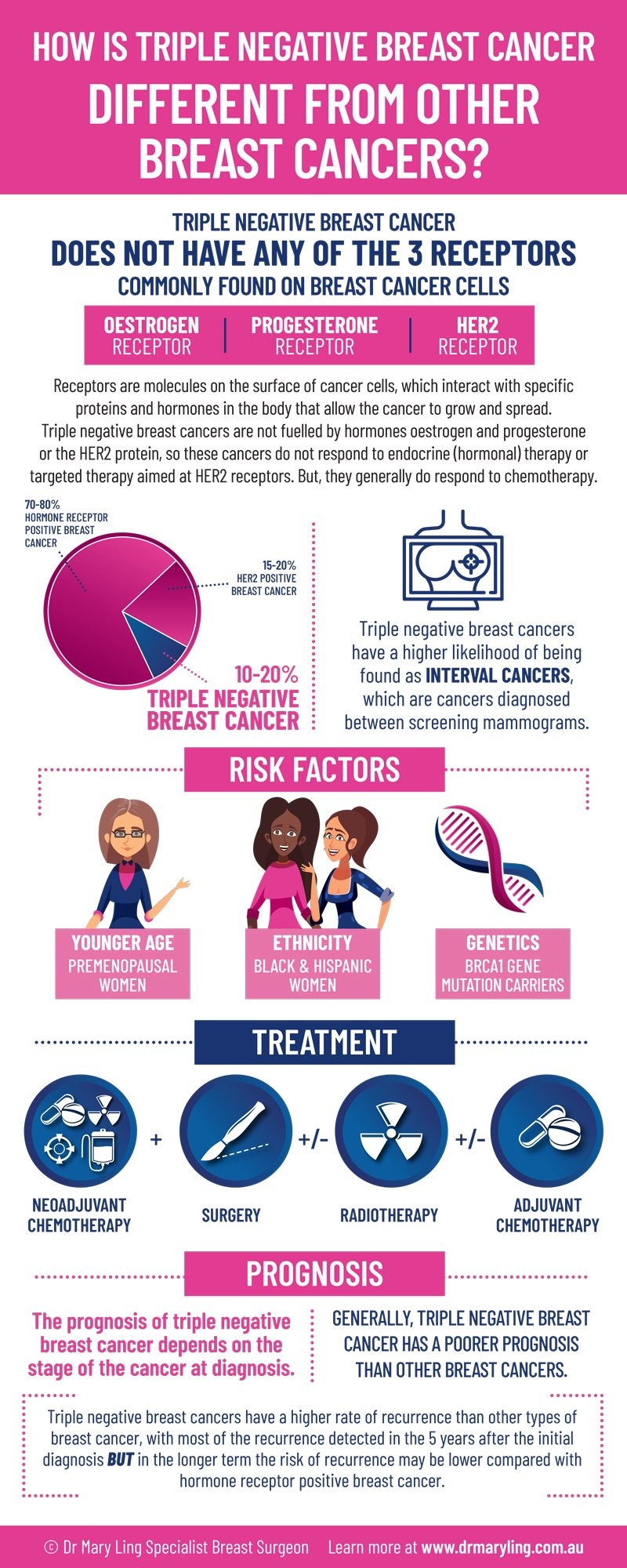
Contents
- 1 Triple-Negative Breast Cancer
Triple-Negative Breast Cancer
Breast cancer is a malignancy arising from breast cells. Triple-negative breast cancer does not express three common markers found on breast cancer cells: the estrogen receptor (ER), progesterone receptor (PR), and HER2 protein. It accounts for 10%-20% of all breast cancers.
Causes and Risk Factors for Triple-Negative Breast Cancer
While there are known risk factors for breast cancer, the exact cause is unknown.
- Cancer cells result from DNA changes or mutations.
- DNA changes can be inherited or acquired during life.
The causes and risk factors for all types of breast cancer, including triple-negative breast cancer, are:
- Increasing age
- Family history of breast cancer
- Personal history of breast cancer
- Atypical hyperplasia (certain kinds of benign breast disease)
- Young age at menstruation or late menopause
- Dense breast tissue
- Radiation exposure
- First-time childbirth after age 30 or never giving birth
- Overweight and obesity
- Postmenopausal hormone therapy use
- Alcohol consumption
- Genetic risk factors (BRCA-1 and BRCA-2 mutations)
Unlike other types of breast cancer, triple-negative breast cancer is more common in African-American and Hispanic women, as well as younger women. About 70% of cancers in women with a BRCA-1 mutation are triple-negative.
Symptoms of Triple-Negative Breast Cancer
Triple-negative breast cancers may not cause any symptoms. The most common sign is a painless hard mass in the breast.
Other less common symptoms include changes in breast skin, lumps in the armpit, and changes in the nipple.
Diagnosis of Triple-Negative Breast Cancer
A breast biopsy is necessary to diagnose triple-negative breast cancer.
- Medical professionals may use imaging techniques like mammography for guidance during the biopsy.
- If cancer is confirmed, other tests are conducted on the tissue sample to determine the specific type of cancer.
- Testing for the presence of estrogen receptor (ER), progesterone receptor (PR), and HER2 protein helps classify cancer as triple-negative breast cancer.
Staging of Triple-Negative Breast Cancer
Staging determines the extent and spread of cancer in the body, guiding treatment decisions and offering prognostic information.
Imaging techniques like X-ray, CT scans, bone scans, and PET scans are used to determine if cancer has spread. The stage depends on tumor size, lymph node involvement, and metastasis. Lymph node examination and testing for ER, PR, and HER2 further aid in staging.
- Stage I represents the lowest stage, while stage IV indicates distant metastasis.
Treatment for Triple-Negative Breast Cancer
Treatment for breast cancer is tailored to the cancer type and stage.
Surgery
Breast-conserving surgery (lumpectomy) or mastectomy (complete breast removal) are the two surgical options.
Radiation Therapy
High-energy radiation is directed at cancer cells to destroy them. It is commonly administered after lumpectomy.
Chemotherapy
Chemotherapy is recommended for triple-negative breast cancers larger than 0.5 cm. Hormonal and targeted therapies are not effective for this type. Chemotherapy is administered intravenously or orally.
Types of chemotherapy include:
- Adjuvant chemotherapy, given after cancer removal
- Neoadjuvant chemotherapy, given before surgery to shrink tumors
- Chemotherapy for advanced cancer
Other Therapies
Combination therapy using immunotherapy and chemotherapy is approved for metastatic triple-negative breast cancer.
Prognosis by Stage
Survival rates for breast cancer are based on 5-year survival and vary by stage:
| 100% |
| 93% |
| 72% |
| 22% |
Triple-negative breast cancer generally has a worse prognosis. While there are no specific survival statistics, research aims to identify subtypes for more favorable outcomes. Effective treatments have improved survival rates, with many patients living without recurrence.
Recurrence Rate
- Triple-negative breast cancer has a higher chance of recurrence compared to other types.
- Recurrence risk is highest around 3 years after diagnosis.
- Recurrences are more likely in the lungs or brain than in the bones.
- Late recurrence is less common compared to other types of breast cancer.
From
Cancer Resources
- How Fast Does Breast Cancer Grow?
- A Look at HER2+ Breast Cancer
- HER2- Breast Cancer Treatment


